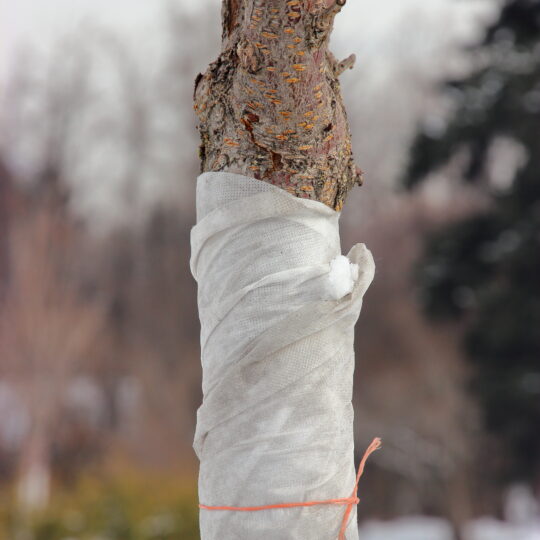Tree Wrap: What You Should Know
How and When to Use it
Posted
January 2, 2025

Finding protection from the frigid winter weather is not always easy. While we can bundle up in a coat, hat, and scarf, these items are not designed to shield plants from the elements. Does nature even need protecting? Some types of plants can benefit from tree wrap this season. Learn how and when wrapping trees works.
What is Tree Wrap?
Like the name suggests, tree wrap is used to wrap the trunk of a tree. It’s designed to protect the bark from extreme temperatures and potential damage. Typically, it’s applied in the late fall before the first frost and should be removed after the last frost in the spring.
There are different types of wrapping material with their own distinct advantages and disadvantages. Most are light in color to reflect sunlight from the bark. This helps to moderate the temperature, keeping it from becoming too warm.
- Polypropylene Fabric. The stretchiness allows for a secure wrap, and it degrades over time to prevent girdling. However, the bright white color does not blend into the landscape.
- Paper. Layers of craft-like paper features an asphalt-based adhesive material between them that breaks down quicker than polypropylene fabric.
- Corrugated Cardboard. Thin, flexible layers of cardboard are cut into strips. It may match the color of the bark, but it doesn’t hold up well in wet conditions.
- Burlap. This woven fabric is made of natural fibers that are breathable and durable. It’s easy to find and inexpensive, but it doesn’t always stay in place during heavy winds, blowing snow, and deer rutting.
While applying the wrap, avoid covering the entire trunk and using wire ties or anything that can cause girdling. You also want to make sure the wrap is snug but not too tight. Here’s how to wrap:
- Start at the bottom of the trunk
- Wind the wrap around the entire base working in an upward angle.
- Overlap slightly as you move up the tree.
- Wrap until you’ve reached the lowest branch.
- Secure it at the top by tucking it in or with a small tack.
If you’re worried about wrapping, there are also tree guards that provide the same benefits, but in a cylindrical tube design that’s placed around the trunk.
Tree Wrapping Benefits
Being outdoors, trees are vulnerable to various environmental and mechanical injuries. Young trees, or ones recently replanted, are the most at risk. Trees with soft bark, such as ash, willow, honeylocust, and crabapple are also more prone to damage. The risk increases during extreme weather, especially when the temperature dramatically swings from day to night. Wrapping a tree works to protect the tree and prevent injury. Here’s how.
- Wrap the trunk in the late fall to protect it from lawn care machinery, such as mowers, trimmers, and aerators.
- Prevent sunscald, which occurs when intense sunlight during the day warms the trunk and triggers the bark to break dormancy. But when the sun sets and the temperature suddenly drops, the active growth shuts down, leaving behind sunken and discolored bark.
- Prevent damage from wood-boring insects.
- When food sources are scarce during the winter, squirrels, rabbits, and deer may turn to the tender bark of your unwrapped tree.
Even though wrapping can help your tree in the winter, it can cause more issues if left on for too long. Remove the wrap once the threat of frost has lifted. Leaving the tree wrapped gives insects a place to hide, becomes an ideal environment for mold growth, and causes damage to the bark and trunk.
Remember, not all trees need wrapping. If your tree is thriving outdoors, it can survive the winter without bundling up. If you’re not sure whether your tree will benefit or not, contact the tree care specialists at Elite Tree Care. We know which types of tree thrives in our local growing zone, and which need a little help surviving the season.

Download Your FREE Tree Planting Guide
Planting a tree is a cinch, as long as you are properly prepared. Get prepped to plant one tree or 100 with our straightforward guide.